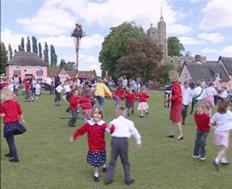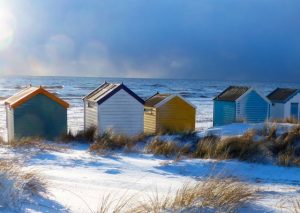
Cavendish Green Kindly supplied by Gareth Davies of Panodream
Cavendish is a large village in the West of Suffolk, between Clare and Long Melford, famous for its much photographed rambling Village Green with pink almshouses nestled in front of a Norman Church tower (see above!)
‘TruGreen’, the world’s largest professional lawn care company, together with ‘The Sunday Telegraph, Life’, have named Cavendish Village Green as the liveliest in the country!
Cavendish Village Green boasts events throughout the year which draw thousands of people to them, from picnics, fetes and fun days, bonfire nights and plant sales to music, dog, art, horticultural and vintage car shows and displays. The village school also makes use of the green for games, sports and their traditional Maypole dancing. And not forgetting the hog roasts!
Head of Marketing for TruGreen, Hannah Banfield, felt that Cavendish Village Green, nominated by villager Mike Ward, fitted the bill of liveliest village green perfectly. She said: “There seems to be an abundance of activities organised here with something for everyone. Village greens are for the enjoyment of everyone living around them”.

Cavendish was also home to the Head Office of the Sue Ryder Foundation until fairly recently, but the building has since been converted to a residential home, Devonshire House. In 1953, Sue Ryder used a small inheritance and some borrowed money to found the Sue Ryder Foundation, whose symbol is rosemary, a sign of remembrance. The foundation was dedicated to the memory of those who had been killed in the two world wars.
Soon after this she opened the first Sue Ryder Home for disabled people. By 1965, she had established 30 homes, where those bearing the scars of the war lived in comfort and without restriction, in England, Germany, Greece, Poland and Yugoslavia.
As Europe rebuilt itself after the war, Sue Ryder became a champion for the dispossessed. She travelled 50,000 miles a year, often driving, carrying supplies across the Continent, supervising the homebuilding and visiting refugees.
Through the years, Lady Ryder’s organization continued to expand. There are now 20 homes in Britain and 80 centres in 20 countries around the world. In Britain, the organization has 2,500 employees.
There are residential centres and day-care centres that provide help for those with long-term illnesses and for those who need palliative care, and centres for people with neurological and degenerative diseases. Each year in Britain, 3,000 people are cared for at the residential centers, 12,000 visits are made to the day centres, and more than 37,000 home visits are made by the nursing staff.
In 1959, Sue Ryder married Group Capt. Leonard Cheshire, a war hero and holder of the Victoria Cross. Captain Cheshire had his own charitable foundation, and he first met his future wife when she visited one of his homes for the disabled. Her husband was elevated to the House of Lords as a life peer in 1991. He died the next year. The couple had two children, Jeremy and Elizabeth.
In 1979, the Queen Mother opened the Sue Ryder Foundation Museum in Cavendish, with exhibitions that included Lady Ryder’s war uniforms and a reconstruction of her mother’s room. Unfortunately the museum is no longer there.
Please see our FULL LIST of Services in Cavendish.
So visit Cavendish soon and see the best that Suffolk has to offer.
How did your visit to Cavendish compare? Do you have a favourite part, shop, inn, restaurant, accommodation? Let us know by contacting [email protected].
